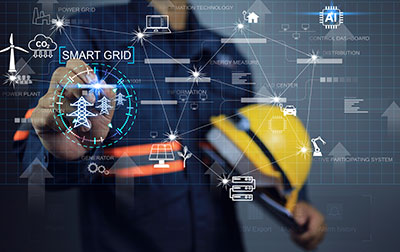Utilizing integrated collaboration to power a smart grid transformation

Addressing the global climate change crisis will require a monumental transformation in the way power is generated, transmitted, and consumed.
Traditional power grids, based on conventional synchronous generation, are being transitioned to smart grids, which include power generated from renewable sources such as wind, solar, and using battery energy storage to manage intermittency.
Most power grids in the world today operate with technologies introduced 50 to 100 years ago. These outdated grids are one-directional systems that distribute electricity from a main power plant to consumers. These systems struggle to integrate renewable energy due to their inability to manage the intermittent nature of the new power sources. Solar and wind energy, after all, are affected by weather and time, which can cause imbalances in production and consumption in the grid.
Not surprisingly, transitioning from the old to the new will be challenging.
The “electrification of everything,” as it is often referred to, is a massive undertaking with high expectations. Modernizing the grid will provide efficient, reliable power for transportation, charging stations, and smart homes and buildings to name but a few applications. According to the International Energy Agency, CO2 emissions are anticipated to reach net-zero by 2050 with renewable energy expected to supply up to two-thirds of global electricity demand.
In the past, developers, owners, investors, and operators have partnered with experienced engineering and advisory professionals to keep their grids online. Transitioning to smart grid technology, however, requires a different array of skillsets than those used in managing conventional grids. Due to the rapid advancements being made in the smart grid and renewable energy sectors, many clients are finding it difficult to find partners who have the expertise to guide their energy transformation.
Integrated collaboration is key
Modernizing a power grid is a process with more moving parts than the destined-to-be-obsolete combustion engine. It requires seasoned partners to collaborate and leverage their combined expertise to produce efficient renewable energy and grid decarbonization strategies in three critical areas (and subcomponents of each)
1. Energy distribution and smart grid
- Digital transformation road mapping and program management
- Distributed energy resources (DERs)
- Automated, integrated smart technology to ensure an intelligent network that communicates throughout transmission and distribution
- Cybersecurity to ensure systems can withstand hacking incidents and other disruptions
- Regulatory services and economic advisory services to navigate complex standards and regulations
- Integrated Remote Operations Centers (IROCs) to monitor operations
2. Power transmission and integration
- Integration of renewable energy via high-voltage, direct current transmission systems and flexible AC transmission systems
- Battery energy storage
- Smart infrastructure development
- Forensic simulations to investigate system issues
- Risk-based asset management to achieve automated optimal system reliability
- Designing resilient renewable energy systems
- Design, engineering, procurement, and construction management
- Community engagement, social performance, environmental assessments and management
- Digital data analysis and modeling
- Energy resource assessments and site selection
We can help
Our integrated eGRID (Electric grid, renewable, intelligent, distributed power systems) team is ready to assist you in navigating the challenges of grid modernization, renewable power generation, energy storage, transmission, and distribution. We have a highly skilled supply of experts that can seamlessly manage all interdependent interfaces and project demands from development and design through to commissioning.
We utilize a combination of industry-leading and in-house software tools, and our unparalleled institutional knowledge over six decades to provide innovative, imaginative solutions for the most complex renewable energy projects
Join us in transforming the future of energy. By partnering with our integrated eGRID team, you can be at the forefront of this significant shift towards sustainable, reliable, and efficient power systems. Let’s work together to modernize the grid, harness renewable energy, and achieve net-zero CO2 emissions by 2050.
To learn more, visit our smart grid, power transmission, and renewable power pages.
Recommended content:
- Adaptation of Power Systems Will Help Weather the Impacts of Climate Change (hatch.com)
- Are LFP batteries the key to meeting North American electric vehicle demand? How previously overlooked chemistry helps overcome headwinds to mass adoption (hatch.com)
- People - the hidden barrier to achieving net zero emissions (hatch.com)
- Transitioning from gas guzzlers to electron expenders: can traditional car manufacturers catch up with Tesla’s market cap? (hatch.com)
- Accessing decarbonization technologies–a timely topic (hatch.com)
